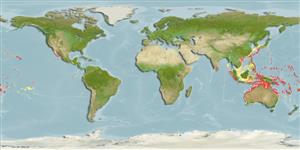分類 / Names
共通名の | 類義語 | Catalog of Fishes(部類, 種) | ITIS | CoL | WoRMS | Cloffa
>
Gobiiformes (Gobies) >
Gobiidae (Gobies) > Gobiinae
Etymology: Trimma: Greek, trimma, -atos = something crushed (Ref. 45335); maiandros: Named for Maiandros, the god of the winding Maeander River in Phrygia (currently known as the Büyük Menderes River in Turkey), son of Oceanus and his sister Tethys. The English word 'meander', a winding, crooked, or involved course, is in allusion to the zigzag pattern of
grey to blue lines on the body; a noun in apposition..
More on authors: Hoese, Winterbottom & Reader.
Environment: milieu / climate zone / depth range / distribution range
生態学
海 関連する礁; 深さの範囲 1 - 55 m (Ref. 86820). Tropical
Indo-Pacific: Cocos (Keeling) Islands in the Indian Ocean and from Japan, Marshall and Mariana Islands to Samoa and Australia in the Pacific.
サイズ / 重さ / 年齢
Maturity: Lm ? range ? - ? cm
Max length : 2.7 cm SL オス/雌雄の選別がない; (Ref. 86820)
簡単な記述
形態学 | 形態計測学
背面の脊椎 (合計): 6 - 8; 背鰭 (合計): 8-10; 肛門の骨 1; 臀鰭: 7 - 9; 脊つい: 26. This species is characterized by the following: reduced predorsal scales, usually not crossing the midline (midline naked or partly naked); cycloid scales at sides of nape reaching to above a point between posterior margin of operculum and eyes; no scales on cheeks nor opercles; pectoral base usually fully scaled, posterodorsal 2 scales slightly enlarged; prepelvic covered with small cycloid scales in 5-6 rows; interorbital narrow, with moderate groove; groove absent or very shallow behind eyes (shallow between eyes and absent behind eyes in juveniles); a low distinct ridge at posterior end of interorbital; gill opening extending forward to below posterior margin of pupil; nape crest low from first dorsal origin to above posterior opercular margin, reaching to the shallow median groove; groove extending to just behind eyes; pectoral rays unbranched or with 1-5 rays branched at extreme tips; fifth pelvic ray unbranched, rest of rays with 2 terminal tips; D2 usually I,9; A usually I,8; pelvic fins largely separate, connected only at base; fins widely separate, distance between 2 fins greater than base of single pelvic fin; pelvic scale covering membrane, with fifth ray about one-fourth to one-half length of fourth ray; dark brown spot or bar extending posteroventrally from eye, body with irregular brown interconnecting bars, forming zigzag pattern (Ref. 86884).
Occurs in mid to outer barrier reefs, but much more common on outer barrier islands (Ref. 86820). Also found in caves and crevices (Ref. 90102).
Life cycle and mating behavior
成熟 | 繁殖 | 放精 | 卵 | 生産力 | 幼生
Hoese, D.F., R. Winterbottom and S. Reader, 2011. Trimma maiandros, a new species of pygmy goby (Gobiidae) from the Indo-west Pacific. aqua, Int. J. Ichthyol. 17(2):103-110. (Ref. 86820)
Human uses
より多くの情報
共通名の類義語代謝捕食動物生態毒性繁殖成熟放精卵の集合体生産力卵卵の開発
Age/Size成長体長-重さLength-length体長組成形態計測学形態学幼生幼生の動力補充豊度BRUVS
参考文献水産養殖水産養殖の紹介緊張遺伝子のElectrophoreses遺伝病気行列NutrientsMass conversion
協力者画像Stamps, Coins Misc.音シガテラ(食中毒の名前)速度泳ぐ 型式カマOtoliths脳視覚
用具
特記事項
XMLをダウンロードして下さい
インターネットの情報源
Estimates based on models
Preferred temperature (Ref.
123201): 24.3 - 28.8, mean 27.5 °C (based on 344 cells).
Phylogenetic diversity index (Ref.
82804): PD
50 = 0.5000 [Uniqueness, from 0.5 = low to 2.0 = high].
Bayesian length-weight: a=0.01023 (0.00477 - 0.02194), b=3.02 (2.84 - 3.20), in cm total length, based on LWR estimates for this (Sub)family-body shape (Ref.
93245).
Fishing Vulnerability (Ref.
59153): Low vulnerability (10 of 100).
Nutrients (Ref.
124155): Calcium = 324 [142, 907] mg/100g; Iron = 1.54 [0.71, 3.20] mg/100g; Protein = 18.1 [16.0, 19.9] %; Omega3 = 0.182 [0.066, 0.460] g/100g; Selenium = 31.9 [11.5, 78.9] μg/100g; VitaminA = 129 [30, 535] μg/100g; Zinc = 3.81 [2.21, 6.09] mg/100g (wet weight);
